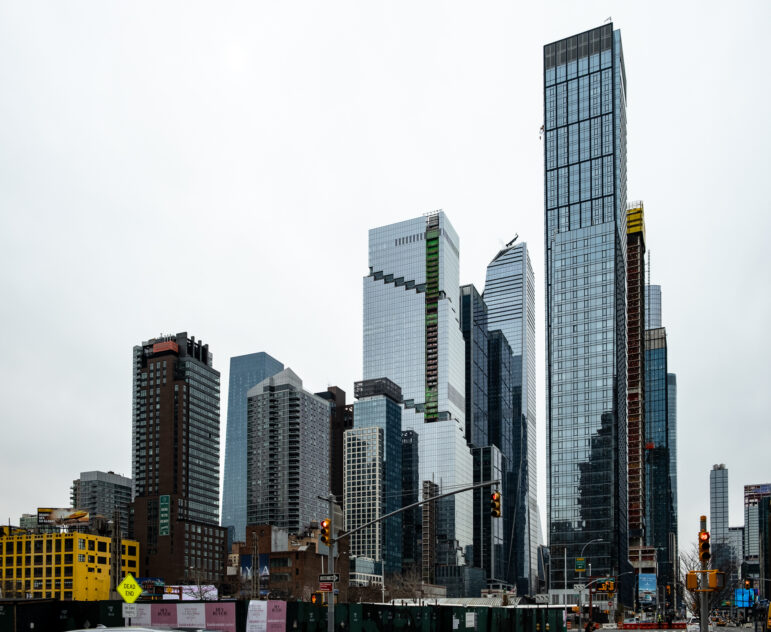
Ozone Pollution from New York Buildings On the Rise, Study Finds
Buildings don’t just contribute to greenhouse gas emissions: a new study finds they are also adding to the smog that hovers over New York City’s streets.
Adi Talwar
Skyscrapers on the west side of Manhattan.
You know that thick layer of smog that tends to blanket New York City, especially in the summer? That pollution is called ground level ozone, and it’s caused when particles emitted from burning fossil fuels like oil and gas are exposed to sunlight as cars, power plants and other sources launch them into the air.
But a new study commissioned by the environmental group Sierra Club says an another culprit may be adding to the smog: buildings.
The maximum contribution of statewide building emissions to ozone pollution in New York City rose 65 percent from 2016 to 2023, according to the report.
Long-term exposure to ozone can be dangerous. It can lead to reproductive issues like reduced fertility or increase the risk of cancer and death brought on by heart diseases, according to the American Lung Association. It’s also associated with increased respiratory illnesses like asthma as it inflames the airways.
“Breathing ozone is basically like getting a sunburn on your lungs,” says Sierra Club Senior Attorney Josh Berman, who spearheaded the report alongside the consulting firm Sonoma Technology.
The study used a model developed by the U.S. Environmental Protection Agency (EPA) that tracks different types of pollutants emitted in the United States through space and time. The model evaluates how they interact and pinpoints where they come from. By finding the source of the pollution, researchers were able to trace it back to buildings across the state.
Berman explains that because pollution in the United States generally blows from west to east, ozone emitted from buildings across New York are making their way down to the Big Apple, contributing to poor air quality in the city.
“Part of the reason the contribution to ozone levels from buildings increased between 2016 and 2023 is that we are not bringing down building emissions fast enough in the way that we are bringing down emissions from vehicles or coal plants,” Berman said.
“So their contribution [to ozone pollution] is becoming relatively larger,” he added.
While gas hookups in new construction are being phased out in New York on both the local and state levels, Berman says the transition just isn’t happening quickly enough. The mandate is in effect for new buildings of seven stories or less in New York City, but the law will apply only to larger buildings starting in 2027. A statewide policy will go into effect in 2026.
Most homes across New York still use polluting energy sources for cooking and heating. Statewide, 85 percent of single family homes “rely on fossil fuels such as propane, fuel oil and methane gas for water heating,” according to the Sierra Club.
And although residents technically don’t need their boilers on over the summer to heat their homes, many buildings in New York City still use them to provide hot water. The practice wastes energy and contributes to the pollution that leads to ozone formation.
In multifamily properties, 80 percent used their space-heating steam boilers to serve both their heating and hot water needs, according to a most recent assessment of the city’s energy and water use data released in 2017.
Adi Talwar
In multifamily properties, 80 percent used their space-heating steam boilers to serve both their heating and hot water needs.
One way to tackle the problem and cut back on ozone pollution is to swap out the boiler for a heat pump, which is more efficient, using less electricity to produce heat.
“If you had a heat pump water heater for a building where it was appropriate, that heat pump water heater will take energy out of the ambient air and then use that to heat up the water,” explains Lisa Marshall, advocacy and organizing director at New Yorkers for Clean Power.
While Marshall warns that heat pumps aren’t a silver bullet that will work for every building type, she says Sierra Club’s ozone pollution study adds to the urgency that New York must speed up its transition to cleaner sources of energy.
Buildings are already New York City’s largest climate change contributor as they are responsible for 70 percent of the greenhouse gas emissions emitted in the city. And now there is evidence that they are adding to ozone pollution as well.
“This data has led me to believe that there’s actually more air pollution from gas than people realized or thought that there was,” Marshall said. “And that is something worth pursuing and investigating further.”
To reach the reporter behind this story, contact Mariana@citylimits.org. To reach the editor, contact Jeanmarie@citylimits.org
Want to republish this story? Find City Limits’ reprint policy here.
The post Ozone Pollution from New York Buildings On the Rise, Study Finds appeared first on City Limits.

